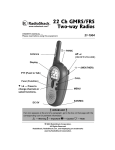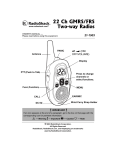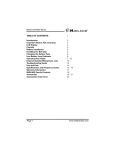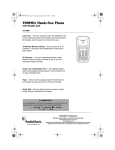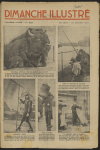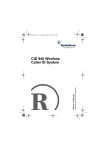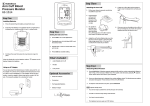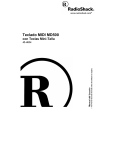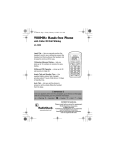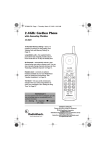Download Radio Shack 22CH GMRS/FRS Owner`s manual
Transcript
www.radioshack.comSM 22 Ch GMRS/FRS Two-way Radios OWNER’S MANUAL — Please read before using this equipment. Antenna 21-1902 off (ON/OFF/VOLUME) CALL (Up) / (Down) MENU PTT RP T FUNC EAR/MIC DC 6V Wrist Strap ! IMPORTANT ! If an icon appears at the end of a paragraph, go to the box on that page with the corresponding icon for pertinent information. o — Warning ! — Important — Caution Ô — Note © 2003 RadioShack Corporation. All Rights Reserved. RadioShack, RadioShack.com, and Adaptaplug are trademarks used by RadioShack Corporation. CONTENTS Contents Introduction ............................................................................................. 3 Package Contents ............................................................................... 5 A Quick Look at the Display ................................................................... 6 Powering the Radio ................................................................................ 6 Using Batteries .................................................................................... 6 Recharging Ni-Cd or Ni-Mh Batteries .................................................. 8 Operation .............................................................................................. 10 Turning the Radio On/Off and Adjusting the Volume ........................ 10 Transmitting ....................................................................................... 10 Selecting a Channel .......................................................................... 10 FRS Frequencies Chart .................................................................... 11 Selecting Quiet Codes ...................................................................... 12 Quiet Code Chart .............................................................................. 13 Using Scan ........................................................................................ 14 Using Key Lock ................................................................................. 14 Using Key Tone ................................................................................. 14 Using VOX ........................................................................................ 15 Using APO ........................................................................................ 15 Using Hi/Lo Transmitter Power ......................................................... 16 Using Courtesy Tone ......................................................................... 16 Using a Headset ................................................................................ 17 Direct Call Operation ............................................................................ 17 Setting Home ID ................................................................................ 20 Setting Direct Call ............................................................................. 20 Call Melody ....................................................................................... 21 Using the Swivel Belt Clip ................................................................. 21 Using an Optional Wrist Strap ........................................................... 22 Care ...................................................................................................... 22 Service and Repair ............................................................................... 22 FCC Information ................................................................................... 23 FCC License Required ...................................................................... 23 The FCC Wants You to Know ........................................................... 25 Safety Information ................................................................................ 26 2 INTRODUCTION Thank you for purchasing a pair of RadioShack 22 Ch GMRS/FRS Twoway Radios. They provide short-range (up to about 5 miles) voice radio communication to let families and groups keep in touch with each other on specific reserved channels. You can use these lightweight, palmsized radios to talk with another person who has a GMRS/FRS radio set to the same frequency as your radios. Introduction Your radios have 22 channels and 38 different quiet codes. Your radios also have auto-squelch, so you will not hear anything on a channel unless someone is transmitting nearby on the same channel. You can connect an optional speaker/ microphone and earphone to the radios (neither supplied, available at your local RadioShack store). Your radio’s display has a backlight that turns on for about 5 seconds when you press any key except PTT. 3 Your radio’s other features include: • Channel Scan — use to find other GMRS/FRS users. • Key Beep — each time you press a key, except PTT or FUNC, the radio beeps once. • Voice Operated Transmission (VOX) — enables standalone usage and works with handsfree accessories. Introduction • Automatic Power Off — you can set the amount of time before the radio automatically turns itself off when it is idle (30, 60 or 90 minutes). • Hi/Lo Power Selection — select 0.5W or 1.0W transmit power for a GMRS channel. • Courtesy Tone — at the end of transmission, the radio receiving a transmission sounds a tone to confirm the end of the transmission. • Direct Call — you can select the radio you want to hear your transmission. Only that radio receives a call you address to it and displays the transmitter’s number identifying your radio on its display. 4 • Phase-lock Loop (PLL) Controlled Circuitry — provides accurate and stable channel selection. PACKAGE CONTENTS Introduction Radios (2) Dual Charger Rechargeable NiMH Batteries (8) 9V 500 mA AC Adapter Owner’s Manual (1) Quick Start (1) Belt Clip 5 A QUICK LOOK AT THE DISPLAY Channel Indicator MISS ID Indicator Keypad Lock 500mW Low Power Key Beep Courtesy Tone Battery Level Meter CTCSS Code Indicator Signal Strength Meter Function Transmit Voice Operated Transmission (VOX) Ô Battery Notes Ô A Quick Look at the Display • Dispose of old batteries promptly and properly. • Do not burn or bury batteries. • Use only fresh batteries of the required size and recommended type. (Continued) 6 Scan Automatic Power Off (APO) POWERING THE RADIO USING BATTERIES Your radios require four AAA rechargeable nickel-metal hydride (NiMH) batteries (supplied), or four AAA rechargeable nickel-cadmium (Ni-CD) batteries (not supplied), or four AAA alkaline batteries (not supplied) for power.Ô • 2. Pull down the latch on the battery compartment cover. Then remove the cover. 3. Slide CHARGE ON/OFF inside the battery compartment to OFF (for alkaline batteries) or ON (for Ni-MH or Ni-Cd rechargeable batteries) when charging the battery through the 6V DC jack on the bottom of the radio. o WARNING o If you use nonrechargeable batteries, be sure to set CHARGE ON/ OFF to OFF. Nonrechargeable batteries can get hot and explode if you try to recharge them. o 4. Install four AAA batteries according to the polarity symbols (+ and –) marked inside. 5. Replace the cover and push the latch up until it clicks. Turn on the radio by rotating off counterclockwise until it clicks. Ô Battery Notes Ô (Continued) • Do not mix old and new batteries, different types of batteries (standard, alkaline, or rechargeable), or rechargeable batteries of different capacities. • If you do not plan to use the radios for a month or more, remove the batteries. Batteries can leak chemicals that can destroy electronic parts. 7 Powering the Radio 1. To turn off the radio, rotate off clockwise until it clicks. ! IMPORTANT ! Powering the Radio The EPA certified RBRC® Battery Recycling Seal on the nickel-cadmium (Ni-Cd) battery indicates RadioShack is voluntarily participating in an industry program to collect and recycle these batteries at the end of their useful life, when taken out of service in the United States or Canada. The RBRC program provides a convenient alternative to placing used Ni-Cd batteries into the trash or the municipal waste stream, which may be illegal in your area. Please call 1-800THE-SHACK (1-800-8437422) for information on NiCd battery recycling and disposal bans/restrictions in your area. RadioShack’s involvement in this program is part of the company’s commitment to preserving our environment and conserving our natural resources. appears on the display to show that the battery is full. Segments disappear as the battery weakens. to indicate how much battery power remains. When flashes, replace alkaline batteries or recharge Ni-Cd or Ni-MH batteries. ! RECHARGING NI-CD OR NI-MH BATTERIES You can use the supplied dual charger to charge the radio’s batteries. You can also use an optional 6V, 600mA AC-DC adapter and a size F AdaptaplugTM connector (not supplied) to charge the radio’s batteries, or an optional 6V, 1000mA DC-DC adapter and a size F AdaptaplugTM connector (not supplied) to charge the radio’s batteries and power the radio. Using the Supplied Dual Charger or Optional AC or DC Adapter Supplied Dual Charger 1. To turn off the radio, rotate off clockwise until it clicks. 8 3. Pull down the latch on the battery compartment cover, then remove the cover. 4. Set CHARGE ON/OFF to ON. 5. Place four Ni-CD or Ni-MH batteries in the radio’s battery compartment according to the polarity symbols (+ and –) marked inside, then replace the cover and push the latch up until it clicks. 6. To use an optional AC or DC adapter, attach the Adaptaplug to the adapter so TIP reads positive (+). Then connect the Adaptaplug’s other end to the radio’s DC 6V jack. Then plug the adapter into a standard AC outlet or vehicle’s power source. Otherwise, to use the supplied dual charger, simply place the radios in the charger. Ô 7. When charging is complete, remove the radios from the dual charger or unplug the AC or DC Ô NOTE Ô • The charger might not supply enough current to charge the batteries if you use the radio to transmit at the same time. • To ensure proper charging, use a pencil eraser to clean the contacts on the bottom of the radio and inside the dual charger. CAUTION You must use a Class 2 power source that supplies regulated 6V DC (Not more than 6V) and delivers at least 600mA. Its center tip must be set to positive and its plug must fit the radio’s DC 6V jack. Using an adapter that does not meet these specifications could damage the radio or the adapter. 9 Powering the Radio 2. To use the supplied dual charger, connect the supplied AC-DC adapter to the jack on the back of the dual charger. Then plug the other end into an AC socket. Ô Ô NOTE Ô • Operation • It takes about 10 hours to fully charge rechargeable batteries using the supplied dual charger. It takes about 2 hours to fully charge rechargeable batteries using an optional AC or DC adapter or quick charger (such as RadioShack Cat. No. 21-1930). The charger might not supply enough current to charge the batteries if you use the radio to transmit at the same time. • Use of this radio outside the country in which it was intended to be distributed is subject to government regulations and may be prohibited. • To save power, the radio automatically stops transmitting if you hold down PTT for about two minutes. 10 adapter from the power source. Then disconnect it from the radio’s DC 6V jack. Ô OPERATION TURNING THE RADIO ON/OFF AND ADJUSTING THE VOLUME Rotate off to turn the radio on or off and adjust the volume.Ô TRANSMITTING Hold down PTT to transmit. TX appears. Release PTT to stop transmission.Ô SELECTING A CHANNEL Press or to select the desired channel. The selected channel number appears Channel Frequency (MHz) Description 1 462.5625 FRS 1/GMRS Interstitial 1 2 462.5875 FRS 2/GMRS Interstitial 2 3 462.6125 FRS 3/GMRS Interstitial 3 4 462.6375 FRS 4/GMRS Interstitial 4 5 462.6625 FRS 5/GMRS Interstitial 5 6 462.6875 FRS 6/GMRS Interstitial 6 7 462.7125 FRS 7/GMRS Interstitial 7 8 467.5625 FRS 8 9 467.5875 FRS 9 10 467.6125 FRS 10 11 467.6375 FRS 11 12 467.6625 FRS 12 13 467.6875 FRS 13 14 467.7125 FRS 14 15 462.5500 GMRS Primary 1 16 462.5750 GMRS Primary 2 17 462.6000 GMRS Primary 3 18 462.6250 GMRS Primary 4 19 462.6500 GMRS Primary 5 20 462.6750 GMRS Primary 6 21 462.7000 GMRS Primary 7 22 462.7250 GMRS Primary 8 Operation FRS FREQUENCIES CHART 11 SELECTING QUIET CODES Quiet Codes lets you talk and listen to other radios set to the same channel and quiet code. This is like having a sub-channel within a channel, giving you greater communication flexibility. When you set a quiet code (there are 38 codes to choose from) and turn on this feature, you can communicate with anyone who has a radio set to the same channel and quiet code. Operation To select the desired quiet code, hold down FUNC. FUNC appears on the display. Repeatedly press or hold or until you see the code number you want to use. To turn off the quiet code feature, hold down FUNC and repeatedly press or hold or at the same time until the quiet code number disappears. 12 QUIET CODE CHART Frequency (Hz) CTCSS No. Frequency (Hz) 1 67.0 20 131.8 2 71.9 21 136.5 3 74.4 22 141.3 4 77.0 23 146.2 5 79.7 24 151.4 6 82.5 25 156.7 7 85.4 26 162.2 8 88.5 27 167.9 9 91.5 28 173.8 10 94.8 29 179.9 11 97.4 30 186.2 12 100.0 31 192.8 13 103.5 32 203.5 14 107.2 33 210.7 15 110.9 34 218.1 16 114.8 35 225.7 17 118.8 36 233.6 18 123.0 37 241.8 19 127.3 38 250.3 Operation CTCSS No. 13 Ô NOTE Ô Operation Using Scan • The radio automatically scans through quiet codes while scanning through the channels. The quiet code feature automatically turns on when a signal is detected on a channel and quiet code, and turns off after the signal disappears. • During scan, the radio will not receive Direct Call data. Using Key Tone When you do not press a key after 20 seconds, while in the Menu, the radio exits the Menu without saving your settings. USING SCAN Press and hold or to scan up and down to find the desired channel and quiet code. The radio automatically scans through the channels and pauses on each active channel. While scanning, press or to change the scanning direction. Press PTT to stop scanning. Ô USING KEY LOCK To lock or unlock the keypad, hold down FUNC and press PTT to lock or unlock the keys. appears when the keys are locked. When the keypad is locked, you can still transmit (press PTT), send a call (press CALL) or temporarily enable/disable Vox (press PTT when Vox level is 1–4). USING KEY TONE You can set the radio so it sounds a tone when you press any key except PTT or FUNC. To turn on the key tone, press MENU to activate the Menu function and press or until and ON appear. Press PTT to store the setting. Ô 14 To turn off the key tone feature, press the MENU key to activate the Menu function and press or until and OFF appears. Press PTT to store the setting. USING VOX USING APO You can set the radio to automatically turn off when the radio is idle (no key is pressed and nothing is transmitted or received) for 30, 60 or 90 minutes. To turn APO (Automatic Power Off) on/off, continually press MENU key until APO and 30, 60, 90 or OFF appears. Press or to select the desired amount of time or OFF. If you select OFF, the radio does not automatically turn off. Before the radio shuts off, it beeps. To activate the radio, press any key. Make sure the radio is set to ON by setting the rotary switch to on, the radio beeps when you turn it on. Ô NOTE Ô • If you have selected a Vox level, the radio’s backlight turns on for about 5 seconds when you press PTT. • You still can send a page to other FRS radios in Vox mode when the keys are locked. • When you do not press any key within 20 seconds after entering this mode, the radio exits the Menu without saving any changes. 15 Operation Vox operation allows you to transmit a voice message without pressing any key. To activate Vox, repeatedly press MENU until VOX appears. Press or to select the desired level (1– 4) (i.e. Lo-Hi), select OFF to turn Vox off. Press PTT to store the setting. Ô USING HI/LO TRANSMITTER POWER Ô NOTE Ô Operation The Hi/Lo transmit selection is not available when using FRS Channels 8–14. You can set the radio transmit power to 0.5W or 1.0W. The transmit power of channel 8–14 is fixed at 0.5W only (FRS channel). To select 1.0W transmit power, make sure that the radio is not on channels 8–14 and then press MENU until Lo appears. If you select OFF, the radio transmit power is 1.0W; select ON to set the transmit power to 0.5W. If you do not press any key within 20 seconds after entering this mode, the radio exits the Menu without saving any changes.Ô USING COURTESY TONE You can set your radio so the person you are communicating with will hear a tone when you finish transmitting. To turn on the radio courtesy tone, press MENU repeatedly. appears and ON/ OFF flashes on the display. ON appears when the courtesy tone is on and OFF appears when the courtesy tone is off. Press or to turn the courtesy tone on or off. Press PTT to store the setting. 16 You can make or answer calls with handsfree convenience using an optional headset with a 3/32-inch plug (not supplied, available at your local RadioShack store). To connect a headset, insert the headset’s plug into the EAR/MIC jack on the bottom of the radio. Ô DIRECT CALL OPERATION The Direct Call data includes the transmitter ID and receiver ID information. You can use the transmitter to select the receiver radio’s ID number you want to call, and the receiver radio only receives the Direct Call data you select. The Direct Call data communication is based on the same Channel and CTCSS code setting. You cannot establish communication if the Channel and CTCSS code for both radios are not the same. Ô NOTE Ô Using a Headset Do not change your headset’s mode (VOX or PTT) while the radio is in use and be sure to switch your radio off to reset it before switching between VOX and PTT. Direct Call Operation If a channel is being used by another user, your radio might miss Caller ID messages due to RF interference. Direct Call Operation USING A HEADSET Direct Call data is sent when you press CALL. The radio transmits Direct Call data to the desired radio. 17 At the same time, the other radio checks the receiving Direct Call data at the same Channel and CTCSS code. If the Caller ID number matches its Home ID (Receiver ID number) or equivalent Group Call, then it recognizes that the call is addressed to this radio. As a result, the receiver will display the Sender ID number on the LCD and generate a call melody. There are five different call melodies to let the user determine who is transmitting a call. Direct Call Operation After Direct Call transmission is completed, both radios (Transmitter and Receiver) will change their CTCSS code setting to Private code for 15 seconds. It is used to avoid interruption from original Channel and CTCSS code. During the 15-second period, both radios can only transmit and receive voice message at the original Channel with Private Code. Also, the ID icon on both radios flashes on the display to indicate this 15-second period. When the conversation is made within this period, the 15-second time out is extended for another 15 seconds. To exit the 15-second period, press CALL or wait for the 15 second time out. After a 15-second time out, both radios are restored to their original settings 18 and the display reverts back to the display without the Direct Call function. Direct Call Operation On the other hand, if you do not press any key on the receiver after a Direct Call is received, its LCD display continues showing the received ID number and MISS ID (Missed ID) flashes until you press any key (except FUNC). Also, the radio generates a beep to remind you that there is an incoming call and it continues beeping once every 10 minutes for a period of 30 minutes.To stop the beeps, press any key except FUNC. 19 SETTING HOME ID Ô NOTE Ô • If you do not press a key within 20 seconds when setting the Home ID, the radio automatically exits Home ID without saving your settings. Home ID data allows you to enter the ID number that will appear on the receiving radio as you communicate with it. You can select Home ID numbers 1–16. 1. Set the transmitter and receiver to the same channel (and same quiet code, if you select one) Direct Call Operation • If Home ID is changed, the radio automatically resets the Direct Call number to Group Call. 2. Hold down FUNC and press CALL to enter Setting Home ID mode. Release all keys and then press or to select your desired Home ID number. • If you press or d to change the Direct Call number and the number is equal to the Home ID. Then the next Direct Call number in order will appear to prevent any conflict of Home ID and Direct Call. 3. Press PTT to store the setting. Ô SETTING DIRECT CALL Direct Call data allows you to enter the receiver’s radio ID number that you want to call. The radio’s receiver only receives the Call when the Direct Call data is matched with it’s Home ID. You can select Direct Call number 1–16 or Group Call. Ô 1. Hold down CALL until the Call ID number flashes on the display, press or to select the receiver’s home ID number or Group option. (If you select 20 receiver’s Home ID number 1-16, you can only send a page to one user or several users with the same ID home number). If you select gP, you can send a page to all users. 2. Press PTT to store the setting. CALL MELODY When you press CALL to send direct call data, a melody specific to the ID number sounds. The person using the radio you are calling also hears the melody specific to that caller ID. The melody and corresponding IDs are shown in the following table. 1 2 3 4 5 For Transmitter Call ID = Group Call Call ID = 1~4 Call ID = 5~8 Call ID = 9~12 Call ID = 13~16 Group Call Sender ID = 1~4 Sender ID = 5~8 Sender ID = 9~12 Sender ID = 13~16 For Receiver Direct Call Operation Call Melody No. ID USING THE SWIVEL BELT CLIP To attach the belt clip, insert the clip into the socket at the back of the radio until it clicks. To remove the belt clip, press the button at the tip of the clip and pull out the clip. 21 ! IMPORTANT ! FCC Information Care Do not open your radio to make any internal adjustments. Your radio is set up to transmit a regulated signal on one of 22 assigned frequencies. It is illegal to alter or adjust the settings inside the radio to exceed those limitations. Any adjustments to your radio must be made by a qualified technician using the proper test equipment. To be safe: • Never open your radio’s case. • Never change or replace anything in your radio except the batteries. • 22 Your radio might cause TV or radio interference even when it is operating properly. To determine whether your radio is (Continued) USING AN OPTIONAL WRIST STRAP You can attach an optional wrist strap (not supplied) to the radio. Slide the wrist strap’s small loop under the bar on the bottom of the radio. You might need to use a small screwdriver or straightened paper clip to do this. Then pull the strap’s large loop through the small loop. CARE Keep the radio dry; if it gets wet, wipe it dry immediately. Use and store the radio only in normal temperature environments. Handle the radio carefully; do not drop it. Keep the radio away from dust and dirt, and wipe it with a damp cloth occasionally to keep it looking new. SERVICE AND REPAIR ! If your radio is not performing as it should, take it to your local RadioShack store for assistance. To locate your nearest RadioShack, use the store locator feature on RadioShack's website (www.radioshack.com), or call FCC INFORMATION FCC LICENSE REQUIRED The Federal Communications Commission (FCC) requires you to have a GMRS license before you operate this radio. To obtain a license, you must be at lease 18 years of age, and cannot be a representative of a foreign government. You must complete FCC Forms 605 and 159 (Fee Remittance Advice) and return them with the applicable fees and Payment/Fee Type Code (PAZR) to the FCC. To obtain the necessary forms, contact the FCC at: Federal Communications Commission Wireless Bureau Applications P.O. Box 358130 Pittsburgh, PA 15251-5130 1-888-CALLFCC (1-888-225-5322) ! IMPORTANT ! (Continued) causing the interference, turn it off. If the interference goes away, your radio is causing it. Try to eliminate the interference by: • Moving your radio away from the receiver. • Calling your local RadioShack store for help. If you cannot eliminate the interference, the FCC requires that you stop using the radio. This device complies with Part 15 of the FCC Rules. Operation is subject to the following two conditions: (1) This device may not cause harmful interference, and (2) this device must accept any interference received, including interference that may cause undesired operation. 23 FCC Information 1-800-The Shack (843-7422) and follow the menu options. Modifying or tampering with the radio's internal components can cause a malfunction and might invalidate its warranty and void your FCC authorization to operate it. o WARNING o There is a penalty for any unlicensed operation of a GMRS radio. To obtain instructions on filing form 605 electronically, go to http:// www.fcc.gov.wtb/uls. This radio is intended for communications from base-to-mobile or mobile-to-mobile stations. Base-tobase communication is not permitted. When you receive your license from the FCC, you are assigned a call sign. You must give your call sign at the end of every communication exchange or once every 15 minutes during a continuous communication. FCC Information The Personal Radio Steering Group (PRSG) is the national user-advocacy organization for the GMRS. The (PRSG provides assistance with licensing and other information about the GMRS, including how to contact and communicate with other GMRS licensees. Personal Radio Steering Group P.O. Box 2851 Ann Arbor, MI 48106 www.provide.net/prsg/ 24 THE FCC WANTS YOU TO KNOW FCC Information This equipment has been tested and found to comply with the limits for a Class B digital device, pursuant to Part 15 of the FCC Rules. These limits are designed to provide reasonable protection against harmful interference in a residential installation. This equipment generates, uses, and can radiate radio frequency energy and, if not installed and used in accordance with the instructions, may cause harmful interference to radio communications. However, there is no guarantee that interference will not occur in a particular installation. If this equipment does cause harmful interference to radio or television reception, which can be determined by turning the equipment off and on, the user is encouraged to try to correct the interference by one or more of the following measures: • Reorient or relocate the receiving antenna. • Increase the separation between the equipment and receiver. • Connect the equipment into an outlet on a circuit different from 25 that to which the receiver is connected. • Consult your local RadioShack store or an experienced radio/TV technician for help. CAUTION Safety Information To maintain compliance with the FCC’s RF exposure guidelines, hold the transmitter and antenna at least 2 inches from your face and speak in a normal voice, with the antenna pointed up and away from your face. If you wear the handset on your body while using the headset accessory, use only the supplied belt clip for this product and when transmitting. take it out of the belt to ensure the antenna is at least 1 inch (2.5cm) from your body. Use only the supplied antenna. Unauthorized antennas, modifications, or attachments could damage the transmitter and may violate FCC regulations. 26 SAFETY INFORMATION Your wireless handheld portable transceiver contains a low power transmitter. When the Push-To-Talk (PTT) button is pressed, it sends out radio frequency signals. The device is authorized to operate at a duty factor not to exceed fifty percent. In August 1996, the Federal Communications Commission adopted RF exposure guidelines with safety levels for handheld wireless devices. SPECIFICATIONS Frequency Range 462.5500–467.7125MHz Channels ................................................. 22 RF Output Power .........Hi power 1.0W ERP Lo power 0.5W ERP Power Supply ................................. 6.0V DC (4 x AAA Batteries) Battery Life .......................... About 16 hours (using alkaline batteries) Optional Accessories Operation Temperature ............ -4 to 122º F (-20º to 50ºC) Dimensions (HWD) . 3.93 × 2.3 × 1.3 inches (100 × 59 × 35 mm) Weight ........................................ 100 grams Specifications are typical; individual units might vary. Specifications are subject to change and improvement without notice. OPTIONAL ACCESSORIES Headset with Mic Alkaline Batteries Cigarette-Lighter Adapter Dual-Bay FAST Charger 27 Limited Ninety-Day Warranty This product is warranted by RadioShack against manufacturing defects in material and workmanship under normal use for ninety (90) days from the date of purchase from RadioShack company-owned stores and authorized RadioShack franchisees and dealers. EXCEPT AS PROVIDED HEREIN, RadioShack MAKES NO EXPRESS WARRANTIES AND ANY IMPLIED WARRANTIES, INCLUDING THOSE OF MERCHANTABILITY AND FITNESS FOR A PARTICULAR PURPOSE, ARE LIMITED IN DURATION TO THE DURATION OF THE WRITTEN LIMITED WARRANTIES CONTAINED HEREIN. EXCEPT AS PROVIDED HEREIN, RadioShack SHALL HAVE NO LIABILITY OR RESPONSIBILITY TO CUSTOMER OR ANY OTHER PERSON OR ENTITY WITH RESPECT TO ANY LIABILITY, LOSS OR DAMAGE CAUSED DIRECTLY OR INDIRECTLY BY USE OR PERFORMANCE OF THE PRODUCT OR ARISING OUT OF ANY BREACH OF THIS WARRANTY, INCLUDING, BUT NOT LIMITED TO, ANY DAMAGES RESULTING FROM INCONVENIENCE, LOSS OF TIME, DATA, PROPERTY, REVENUE, OR PROFIT OR ANY INDIRECT, SPECIAL, INCIDENTAL, OR CONSEQUENTIAL DAMAGES, EVEN IF RadioShack HAS BEEN ADVISED OF THE POSSIBILITY OF SUCH DAMAGES. Some states do not allow limitations on how long an implied warranty lasts or the exclusion or limitation of incidental or consequential damages, so the above limitations or exclusions may not apply to you. In the event of a product defect during the warranty period, take the product and the RadioShack sales receipt as proof of purchase date to any RadioShack store. RadioShack will, at its option, unless otherwise provided by law: (a) correct the defect by product repair without charge for parts and labor; (b) replace the product with one of the same or similar design; or (c) refund the purchase price. All replaced parts and products, and products on which a refund is made, become the property of RadioShack. New or reconditioned parts and products may be used in the performance of warranty service. Repaired or replaced parts and products are warranted for the remainder of the original warranty period. You will be charged for repair or replacement of the product made after the expiration of the warranty period. This warranty does not cover: (a) damage or failure caused by or attributable to acts of God, abuse, accident, misuse, improper or abnormal usage, failure to follow instructions, improper installation or maintenance, alteration, lightning or other incidence of excess voltage or current; (b) any repairs other than those provided by a RadioShack Authorized Service Facility; (c) consumables such as fuses or batteries; (d) cosmetic damage; (e) transportation, shipping or insurance costs; or (f) costs of product removal, installation, set-up service adjustment or reinstallation. This warranty gives you specific legal rights, and you may also have other rights which vary from state to state. RadioShack Customer Relations, 200 Taylor Street, 6th Floor, Fort Worth, TX 76102 12/99 RadioShack Corporation Fort Worth, Texas 76102 21-1902 AO0149AAA1 03A03 Printed in China




























